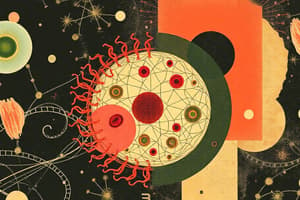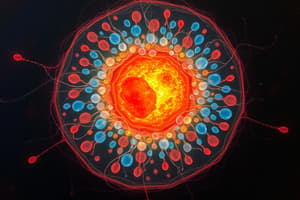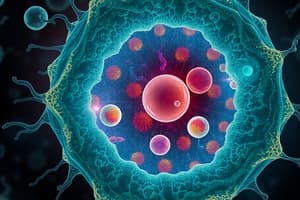Podcast
Questions and Answers
The nucleus is the smallest organelle in a cell.
The nucleus is the smallest organelle in a cell.
False (B)
Eu-chromatin is more coiled and less active genetically compared to hetero-chromatin.
Eu-chromatin is more coiled and less active genetically compared to hetero-chromatin.
False (B)
The nucleolus is a membrane-bound structure found within the nucleus.
The nucleolus is a membrane-bound structure found within the nucleus.
False (B)
The nuclear membrane allows the transport of large molecules in and out of the nucleus through its pores.
The nuclear membrane allows the transport of large molecules in and out of the nucleus through its pores.
Multinucleated cells contain more than one nucleus.
Multinucleated cells contain more than one nucleus.
Ribosomes are membrane-bound structures involved in protein synthesis.
Ribosomes are membrane-bound structures involved in protein synthesis.
The smooth endoplasmic reticulum (SER) is responsible for protein synthesis.
The smooth endoplasmic reticulum (SER) is responsible for protein synthesis.
The Golgi apparatus is involved in sorting, packing, and modifying products from the rough endoplasmic reticulum.
The Golgi apparatus is involved in sorting, packing, and modifying products from the rough endoplasmic reticulum.
The endoplasmic reticulum (ER) consists of a single type of structure with no variation.
The endoplasmic reticulum (ER) consists of a single type of structure with no variation.
Ribosomes can only be found attached to the rough endoplasmic reticulum.
Ribosomes can only be found attached to the rough endoplasmic reticulum.
Flashcards are hidden until you start studying
Study Notes
Nucleus
- The nucleus is the control center of the cell.
- The nucleus is the largest organelle that is easily visible under a microscope because it stains deeply.
- The shape of a nucleus is typically spherical.
- The nucleus contains the genetic material (DNA).
- Cells can be uni-nucleated (one nucleus) or multi-nucleated (multiple nuclei).
- The nucleus controls all cellular activities, including movement and reproduction.
Parts of Nucleus
- The nuclear membrane is a double membrane that surrounds the nucleus and contains pores.
- The nuclear membrane is composed of lipids and proteins, similar to the plasma membrane.
- Ribosomes are attached to the outer membrane of the nuclear membrane.
- The nuclear pores allow the transportation of large molecules into and out of the nucleus.
- Karyolymph (nucleoplasm) is a jelly-like substance rich in proteins and contains chromatin.
Chromatin
- Chromatin is a fibrillar structure or network found in the karyolymph.
- Chromatin condenses to form chromosomes during cell division.
- There are two types of chromatin:
- Eu-chromatin: less coiled DNA and more genetically active.
- Hetero-chromatin: more coiled DNA and less genetically active.
Nucleolus
- The nucleolus is a membrane-less, spherical body found in all eukaryotic cells.
- The nucleolus appears as a dark area in the nucleus.
- The nucleolus contains DNA, RNA, and proteins.
- It is considered a storehouse for RNA and proteins.
- The nucleolus regulates the synthetic activity of the nucleus.
- The nucleolus contains ribosomal RNA (rRNA) and is involved in the production of ribosomes.
Endoplasmic Reticulum (ER), Golgi Apparatus, and Ribosomes
- The Endoplasmic Reticulum (ER), Golgi apparatus, and ribosomes are all single-membrane bound structures composed of proteins and lipids, similar in composition to the plasma membrane.
- The ER is a network of membranes distributed throughout the cytoplasm, connected to the plasma membrane and nuclear membrane.
- There are two types of ER:
- Rough Endoplasmic Reticulum (RER): Contains ribosomes.
- Smooth Endoplasmic Reticulum (SER): Does not contain ribosomes.
- The ER provides an internal framework for the cell, transports enzymes and other materials within the cell, and serves as a site for protein synthesis (RER).
- The SER functions as a site of steroid synthesis and stores carbohydrates.
- Ribosomes are the smallest structures in the cytoplasm of all cell types.
- Ribosomes are spherical structures composed of large molecules of ribosomal RNA (rRNA) and proteins.
- Ribosomes can be found as free particles in the cytoplasm or attached to the RER or the outer nuclear membrane.
- Ribosomes are stored in the nucleolus of the nucleus.
- Ribosomes are the sites of protein synthesis.
Golgi Apparatus (Golgi Bodies)
- The Golgi apparatus is a group of membranous sacs that vary in size and shape.
- There are typically 3-7 Golgi bodies present near the nucleus.
- It is a site of synthesis and secretion of enzymes, involved in sorting, packing, secreting, and modifying RER products.
- The Golgi participates in the transformation of membranes to form other membrane structures, like lysosomes.
Studying That Suits You
Use AI to generate personalized quizzes and flashcards to suit your learning preferences.




